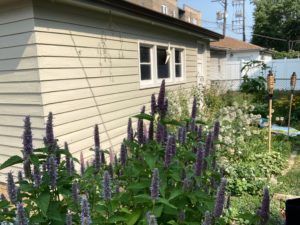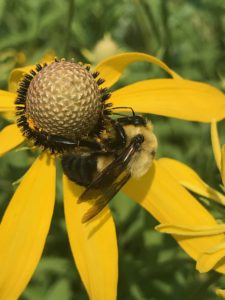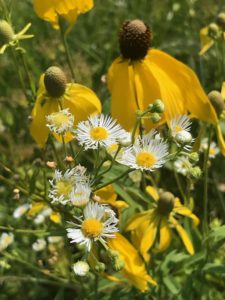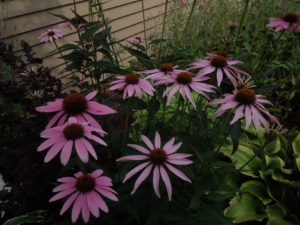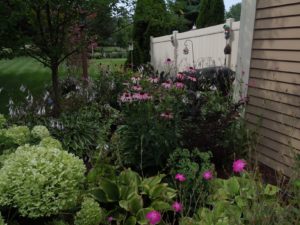Favorite plants that a gardener can depend on year in year out are the hallmark of sustainable gardens. Whether it’s a workhorse in the garden, it shines when other plants have drooped, or its blooms take your breath away, we all have plants we return to again and again.
We thought it would be interesting to learn about some ELA members’ favorite native plants. We requested photos of their favorites and asked why this particular plant stands out among many great choices.
Andrea Wilson Mueller, owner, Inside Out Landscape Design, LLC Franklin, KY
Clustered mountain mint (Pycnanthemum muticum)
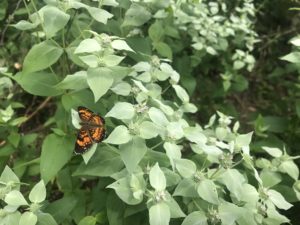
Clustered Mountain Mint (Pycnanthemum muticum)
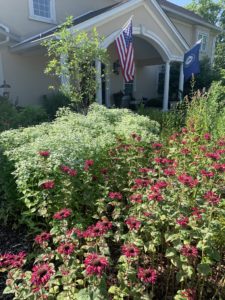
Clustered mounting mint (Pycnanthemum muticum) looks excellent combined with Monarda.
“I love using clustered mountain mint in landscapes because it is so valuable to pollinators and beneficial garden insects, fills in nicely for large/massed areas, and provides a great contrast when in bloom. It works beautifully in the garden and prairies. The bracts are silvery-blue-green-white colored and topped with tiny white and lavender flowers. The bracts are what make this plant pop in the garden and are even showier when combined with native pink or red blooms of coneflower or monarda and/or other blue-green foliaged plants. There really isn’t a bad combination with this plant as long as it has enough room to expand and is best mixed with other spreaders. Mountain mint is a great nectar source for native butterflies and is loved by bees and moths too. Mountain mint provides nectar for an extended period of time with its long July through late summer blooms and is at the top of the charts when it comes to the diversity of pollinators. Clustered Mountain Mint is also deer resistant, smells amazing, and is loaded with natural mosquito repellent!”
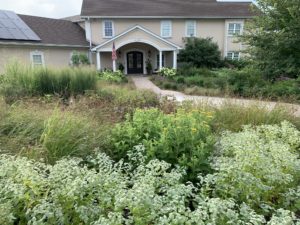
Clustered mounting mint (Pycnanthemum muticum) makes a bold statement in this Kentucky front yard.
Angela Bowman, owner, Bowman Gardens in Chicago, Illinois
Anise hyssop (Agastache foeniculum)
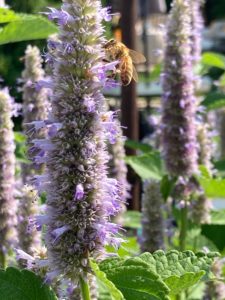
Anise hyssop (Agastache foeniculum) with a bee.
“While it isn’t flashy, a stand of anise hyssop provides a lovely texture in the garden and, when in bloom, will be positively vibrating with bees. As a member of the mint family, its stiff square stems sway in the breeze.
I love it for the aromatic leaves, which taste like anise (or its namesake, fennel) and are a graceful addition to any summer dish, sweet or savory. In fact, I was first introduced to it as an herb as a young gardener and only later learned that it was native to the upper Midwest. In the hot weather, I will crush the leaves and put them in ice water, which is delicately refreshing. But I’ll also put them in green or fruit salads, on ice cream, in a cocktail, or chopped together with other herbs in a soup or meat dish. The flowers are also edible.”
Grey-headed coneflower (Ratibida pinnata)
- Grey-headed coneflower (Ratibida pinnata) with a bee.
- Grey-headed coneflower,(Ratibida pinnata) mixes well with Asters.
“With ray flower petals more slender and drooping than many other coneflowers, the nose is not as prickly as the Echinacea but fuzzy brown with a heavy dusting of yellow pollen. Watching the bees make their way through these morsels throughout the bloom season is one of the great dramas of the late summer prairie. It mingles delicately with other prairie flowers, shown here with some asters.”
Bonnie Prokop, Master Gardener St. Charles, Illinois
Prairie blazing star (Liatris pycnostachya)
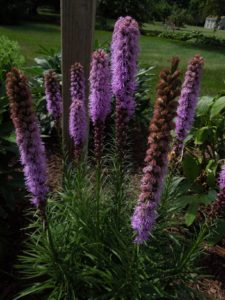
Prairie blazing star (Liatris pycnostachya)
“I appreciate plants that do well in hot, dry conditions, reliably return year after year, attract bees and butterflies, and add colorful blooms and height to my garden.”
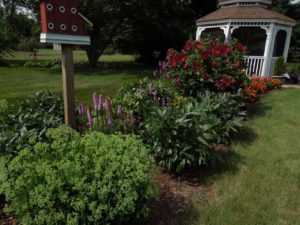
Prairie Blazing Star (Liatris pycnostachya) pictured in the garden.
Pale purple coneflower (Echinacea purpurea)
- Pale purple coneflower (Echinacea purpurea)
- Prairie Blazing Star (Liatris pycnostachya) pictured in the garden.
Kathy Connolly, Landscape Designer, Horticulture Consulting Old Saybrook, CT
Blue mistflower (Conoclinium coelestinum)
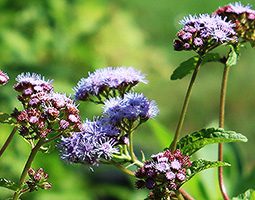
“This beautiful blue flowering perennial is a prodigious bloomer with staying power from August to October. A prolific self-seeder, it is drought-tolerant and never grows more than 3’ tall. It attracts native bees, as well as butterflies, moths, skippers, flies, and beetles.”
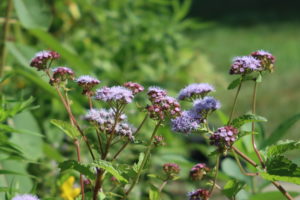
Blue mistflower (Conoclinium coelestinum) is a stunning highlight in a garden.
Chokeberry (Aronia arbutifolia)
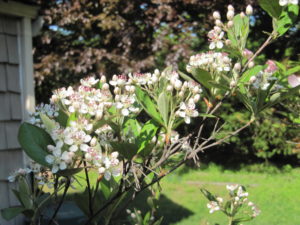
Chokeberry (Aronia arbutifolia) in spring with its soft pink flowers that bees love.
“This shrub works in all four seasons. Spring: Abundant, soft pink flowers. Summer: The vigorous green shrub forms gold-red berries. Fall: The leaves and berries turn cherry red. Winter: Berries persist until about January, offering bird food.”
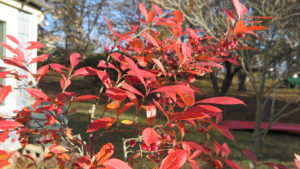
Chokeberry (Aronia arbutifolia)showing its fabulous fall foliage.
Sweet fern (Comptonia peregrina)
“Sweet fern is not a fern. It also doesn’t win any prizes in the plant beauty contest. Yet this fern-like shrub thrives in hot, dry, gravelly areas, particularly slopes. It will colonize such areas, and as a nitrogen-fixing plant, add fertility to disturbed soil and lead the way towards restoration. It is salt, wind, and drought tolerant. In other words, it is a problem solver. It also has a lovely scent and flickers dine on its berries.”
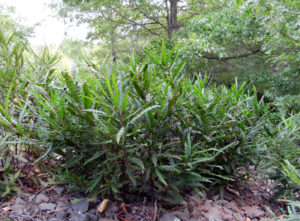
Sweet fern (Comptonia peregrina) solves a problem in this dry garden.
Patricia Dunn, Principal Sabrina Design LLC Palm Beach, Florida
Royal Palm (Roystonea regia)

Royal Palm (Roystonea regia adds a height to this garden.
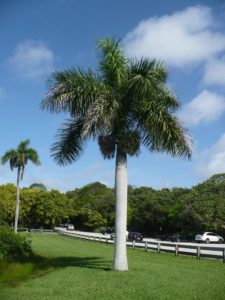
Royal Palm (Roystonea regia)
“Royal Palm(Roystonea regia) is a native tree that grows up to 80’ high and is used as an architectural element. The ornamental tree is used also can be used as a street tree or specimen. Royal Palm grows in full sun.”
Walter’s Viburnum (Viburnum suspensum)
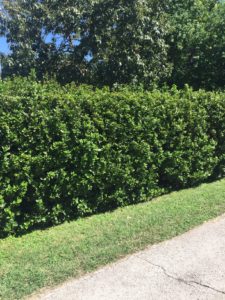
Walter’s Viburnum- (Viburnum suspensum) works well as a native hedge.
“Walter’s Viburnum ((Viburnum suspensum) is a native shrub that is used as a hedge or foundation plant. Excellent as a backdrop for other plants or to camouflage large equipment. In the spring, this Florida native features a mass of small white flowers that attract butterflies and its fall fruit attracts birds and other wildlife. Grows in shade or sun, easily pruned.”

Walter’s Viburnum- (Viburnum suspensum) leaves are glossy and dark green and emit an appealing fragrance when crushed.
Muhly Grass (Muhlenbergia capillaris)
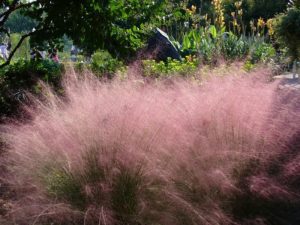
Muhly grass (Muhlenbergia capillaris) is naturally found in Florida’s pine flatwoods, coastal uplands, and even along its highways.
“Muhly Grass (Muhlenbergia capillaris)is a native grass with pink/ purple plumes that appear in the fall. Easy care plant used either as a specimen or layered in front of a hedge. Grows in full to part sun.”
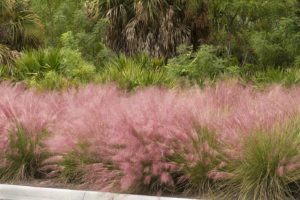
In fall, muhly grass (Muhlenbergia capillaris) produces fluffy pink to purple flower stalks that can reach up to 5 feet tall.
Do you have some favorite plants you would like to share with ELA, send your entries to info@ecolandscaping.org
About the Contributors
Andrea Wilson Mueller started her horticulture career working alongside her dad, who founded the largest nursery in Kentucky. After earning her Bachelor’s degree in design from the University of Kentucky, she kept learning, earning various certifications, including being the only APLD Certified Landscape Designer in Kentucky. Even in her free time, her passion for horticulture shines through: together with her family, she’s planting pollinators and establishing prairies, removing invasive species, and reforesting several acres on their family land. Her passion for the environment and creative solutions is at the heart of her everyday life. Kentucky Landscape Design
Angela Bowman is the owner of Bowman Gardens in Chicago, Illinois (https://www.facebook.com/bowmangardens)**. As a designer and coach/consultant, she focuses on working with native plants, ecological landscaping, and vegetable gardening. After a long career in educational publishing, Angela is dedicated to helping her clients understand how to make their outdoor spaces into hospitable environments for themselves and their families as well as the birds, bees, and other critters who make up our ecological neighborhood.
Bonnie Prokop has been a home gardener for more than 40 years and a Master Gardener volunteer for the University of Illinois for more than 15 years. She has an advanced Master Gardener certification in Sustainable Landscaping, Integrated Pest Management, and Ecology. She lives in St. Charles, Illinois.
Kathy Connolly is a landscape designer, writer, and speaker who emphasizes earth-friendly designs, native plants, and low-impact land care techniques. Artistic design, horticultural science, landscape craft, and an interpretation of how people relate to the location. When those resources are working together, we can produce enduring and satisfying landscape installations. Speaking of Landscapes, LLC
Patricia Dunn, CLD, AOLCP, is an award-winning landscape designer and owner of Sabrina Design. Patricia recently relocated from New England after working over a decade to Palm Beach Gardens, FL, and continues to service clients in Fairfield County, CT, and the Greater Boston area. Her projects include large suburban properties where she partners with architects and interior designers, renovation of spaces post-construction, garden transformations, and seasonal container plantings displays. Patricia also served as the landscape designer for two home renovation projects featured in the April/May and May/June 2017 issues of New England Home magazine. Sabrina Design
***
Each author appearing herein retains original copyright. Right to reproduce or disseminate all material herein, including to Columbia University Library’s CAUSEWAY Project, is otherwise reserved by ELA. Please contact ELA for permission to reprint.
Mention of products is not intended to constitute endorsement. Opinions expressed in this newsletter article do not necessarily represent those of ELA’s directors, staff, or members.

